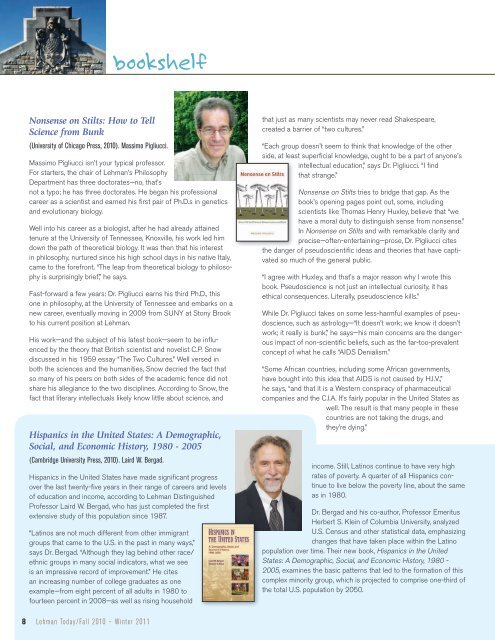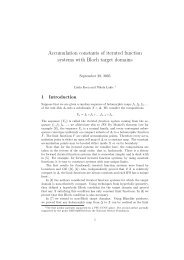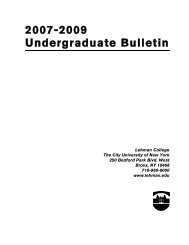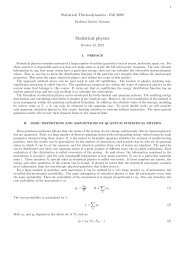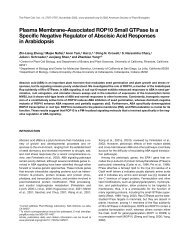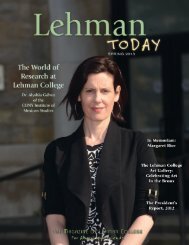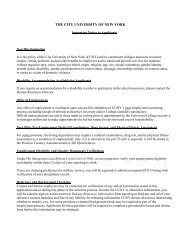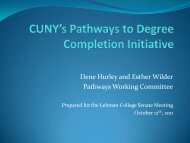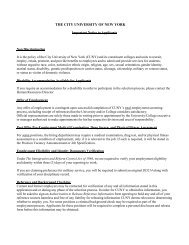Fall 2010 - Lehman College
Fall 2010 - Lehman College
Fall 2010 - Lehman College
Create successful ePaper yourself
Turn your PDF publications into a flip-book with our unique Google optimized e-Paper software.
ookshelf<br />
Nonsense on Stilts: How to Tell<br />
Science from Bunk<br />
(University of Chicago Press, <strong>2010</strong>). Massimo Pigliucci.<br />
Massimo Pigliucci isn’t your typical professor.<br />
For starters, the chair of <strong>Lehman</strong>’s Philosophy<br />
Department has three doctorates—no, that’s<br />
not a typo; he has three doctorates. He began his professional<br />
career as a scientist and earned his first pair of Ph.D.s in genetics<br />
and evolutionary biology.<br />
Well into his career as a biologist, after he had already attained<br />
tenure at the University of Tennessee, Knoxville, his work led him<br />
down the path of theoretical biology. It was then that his interest<br />
in philosophy, nurtured since his high school days in his native Italy,<br />
came to the forefront. “The leap from theoretical biology to philosophy<br />
is surprisingly brief,” he says.<br />
Fast-forward a few years: Dr. Pigliucci earns his third Ph.D., this<br />
one in philosophy, at the University of Tennessee and embarks on a<br />
new career, eventually moving in 2009 from SUNY at Stony Brook<br />
to his current position at <strong>Lehman</strong>.<br />
His work—and the subject of his latest book—seem to be influenced<br />
by the theory that British scientist and novelist C.P. Snow<br />
discussed in his 1959 essay “The Two Cultures.” Well versed in<br />
both the sciences and the humanities, Snow decried the fact that<br />
so many of his peers on both sides of the academic fence did not<br />
share his allegiance to the two disciplines. According to Snow, the<br />
fact that literary intellectuals likely know little about science, and<br />
Hispanics in the United States: A Demographic,<br />
Social, and Economic History, 1980 - 2005<br />
(Cambridge University Press, <strong>2010</strong>). Laird W. Bergad.<br />
Hispanics in the United States have made significant progress<br />
over the last twenty-five years in their range of careers and levels<br />
of education and income, according to <strong>Lehman</strong> Distinguished<br />
Professor Laird W. Bergad, who has just completed the first<br />
extensive study of this population since 1987.<br />
“Latinos are not much different from other immigrant<br />
groups that came to the U.S. in the past in many ways,”<br />
says Dr. Bergad. “Although they lag behind other race/<br />
ethnic groups in many social indicators, what we see<br />
is an impressive record of improvement.” He cites<br />
an increasing number of college graduates as one<br />
example—from eight percent of all adults in 1980 to<br />
fourteen percent in 2008—as well as rising household<br />
that just as many scientists may never read Shakespeare,<br />
created a barrier of “two cultures.”<br />
“Each group doesn’t seem to think that knowledge of the other<br />
side, at least superficial knowledge, ought to be a part of anyone’s<br />
intellectual education,” says Dr. Pigliucci. “I find<br />
that strange.”<br />
Nonsense on Stilts tries to bridge that gap. As the<br />
book’s opening pages point out, some, including<br />
scientists like Thomas Henry Huxley, believe that “we<br />
have a moral duty to distinguish sense from nonsense.”<br />
In Nonsense on Stilts and with remarkable clarity and<br />
precise—often-entertaining—prose, Dr. Pigliucci cites<br />
the danger of pseudoscientific ideas and theories that have captivated<br />
so much of the general public.<br />
“I agree with Huxley, and that’s a major reason why I wrote this<br />
book. Pseudoscience is not just an intellectual curiosity, it has<br />
ethical consequences. Literally, pseudoscience kills.”<br />
While Dr. Pigliucci takes on some less-harmful examples of pseudoscience,<br />
such as astrology—“It doesn’t work; we know it doesn’t<br />
work; it really is bunk,” he says—his main concerns are the dangerous<br />
impact of non-scientific beliefs, such as the far-too-prevalent<br />
concept of what he calls “AIDS Denialism.”<br />
“Some African countries, including some African governments,<br />
have bought into this idea that AIDS is not caused by H.I.V.,”<br />
he says, “and that it is a Western conspiracy of pharmaceutical<br />
companies and the C.I.A. It’s fairly popular in the United States as<br />
well. The result is that many people in these<br />
countries are not taking the drugs, and<br />
they’re dying.”<br />
income. Still, Latinos continue to have very high<br />
rates of poverty. A quarter of all Hispanics continue<br />
to live below the poverty line, about the same<br />
as in 1980.<br />
Dr. Bergad and his co-author, Professor Emeritus<br />
Herbert S. Klein of Columbia University, analyzed<br />
U.S. Census and other statistical data, emphasizing<br />
changes that have taken place within the Latino<br />
population over time. Their new book, Hispanics in the United<br />
States: A Demographic, Social, and Economic History, 1980 -<br />
2005, examines the basic patterns that led to the formation of this<br />
complex minority group, which is projected to comprise one-third of<br />
the total U.S. population by 2050.<br />
8 <strong>Lehman</strong> Today/<strong>Fall</strong> <strong>2010</strong> – Winter 2011


